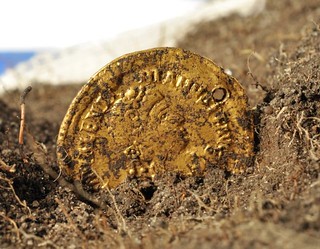
PREV ARTICLE
NEXT ARTICLE
FULL ISSUE
PREV FULL ISSUE
ROMAN COINS FOUND IN REMAINS OF SWEDISH MASSACRE
This article discusses an archeological site on a remote Swedish island, where a nasty massacre occurred some 1,500 years ago. -Editor
Possibly hundreds of people sheltering behind the fort's defenses were executed and abandoned, their bodies left to rot in place without burial. Their wounds were indicative of execution. And some of their mouths were stuffed with goat and sheep teeth, possibly a dark reference to the Roman tradition of burying warriors with coins in their mouths. None of their considerable wealth was looted, which is highly unusual. Researchers have found barely hidden valuables in every house they've excavated. Even the livestock was left behind after the slaughter, locked up to die of starvation. This is even more bizarre than the lack of looting. On an island with scarce resources, it would have been considered a waste for victors (or neighbors) to leave healthy horses and sheep behind after battle. It was a bizarre, kill-all-zombies-style attack. The people of this fort were being shunned, consigned to a "humiliation worse than death," according to archaeologist Helena Victor, who is heading up the dig. We may never know what caused them to suffer such an unusual punishment, but their fate tells us a lot about what life was like on this island in the mid-400s CE. Today known as Sandby Borg, it once enclosed more than 50 family homes. Some 36 percent of the Roman coins found on Öland come from Sandby Borg and surrounding areas. We will probably never know why Sandby Borg was destroyed so thoroughly—and in such an ugly way. From the skeletons uncovered so far, Victor and her colleagues believe it was no pirate raid. This was a political act—another group on the island wanted to consolidate power. And it worked. The shunning was total. Even today, people in local villages say they were warned not to visit the ruins as children because of ghosts and curses. For once, superstition has actually helped the progress of science. Because people were afraid to loot or touch Sandby Borg, the town has remained frozen in time, with all its artifacts intact. It offers archaeologists a perfect snapshot of life in the mid-400s, at a time of dramatic transition for Europe. The researchers have only examined 2 percent of the site, and Victor is hoping the Swedish government will grant permission for them to excavate further. To read the complete article, see:

Wayne Homren, Editor The Numismatic Bibliomania Society is a non-profit organization promoting numismatic literature. See our web site at coinbooks.org. To submit items for publication in The E-Sylum, write to the Editor at this address: whomren@gmail.com To subscribe go to: https://my.binhost.com/lists/listinfo/esylum All Rights Reserved. NBS Home Page Contact the NBS webmaster 
|
